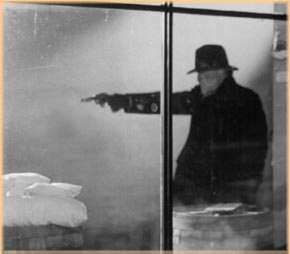Friday, April 28, 2006
Does electron really exist?

Electron is mistery, the biggest ever, as Einstein said once. But after the following story, who can now say that scientists aren't mad? I mean without electron there is no matter.
Bayard Peakes submitted a self-published 33-page photo-offset publication on the non-existence of the electron to present it at the next meeting of the American Physical Society (APS) for mass publication entitled So You Love Physics. Bayard's publication was reject by Karl K. Darrow, head of Bell Labs and the secretary of APS. Other scientists reviewed the publication and described it "as a pointless and elementary discussion of various aspects of physics." Bayard was outraged and planned his revenge.
Near the beginning of July, he went all the way to Bangor, Maine, and purchased a .22-caliber automatic pistol and ammunition for the gun. Eileen Fahey, an 18-year-old secretary who had worked for the APS for the past two years, arrived for work at 9:05 a.m. today with three unopened letters from her fiancé, Ronald Leo, a Marine serving in Korea. The wonderful girl with reddish-blonde hair and blue eyes sat down at her desk, opened one of the letters and began to read it. Dressed in a dark gray suit, Bayard arrived at Columbia University this morning with the intention of killing Karl and any other scientist he could find. He entered the APS office on the ninth floor of the Pupin Building on the campus and saw that only Eileen was in the office.
 Frustrated that his target wasn't there, he lashed out at the only person he could. At 9:20 a.m. Bayard pulled out his pistol and emptied into Eileen's body. Five of the six shots struck her, three of them in her chest, one in her right hand and one in her right forearm. The remaining bullet lodged in the desk. He left the office and encountered another secretary for the APS, Mrs. J. V. Lumley, 32, in the hallway by the elevators. He told her, "You better call the police because I just shot somebody. You better call a doctor. I just shot a female." Bayard then walked down one of the staircases and left the building. Mrs. Lumley raced into the office and found Eileen's body on the floor, one of the letters from Ronald had been open, but the other two were still sealed. An autopsy on Eileen's body found that her heart, lungs, liver, spleen, left kidney and aorta had all been punctured by the bullets. Police initially had no leads in Eileen's murder, until they suspected that her murderer could be a disgruntled former member of the APS.
Frustrated that his target wasn't there, he lashed out at the only person he could. At 9:20 a.m. Bayard pulled out his pistol and emptied into Eileen's body. Five of the six shots struck her, three of them in her chest, one in her right hand and one in her right forearm. The remaining bullet lodged in the desk. He left the office and encountered another secretary for the APS, Mrs. J. V. Lumley, 32, in the hallway by the elevators. He told her, "You better call the police because I just shot somebody. You better call a doctor. I just shot a female." Bayard then walked down one of the staircases and left the building. Mrs. Lumley raced into the office and found Eileen's body on the floor, one of the letters from Ronald had been open, but the other two were still sealed. An autopsy on Eileen's body found that her heart, lungs, liver, spleen, left kidney and aorta had all been punctured by the bullets. Police initially had no leads in Eileen's murder, until they suspected that her murderer could be a disgruntled former member of the APS.The APS supplied police with a list of members and the investigators went to work. Early Thursday morning, July 17, 1952, police arrested Bayard, 29-years-old, in Boston's Back Bay section as he returned home from a dance. He confessed, at length and without remorse, to killing Eileen on the train ride back to New York City. Bayard was wounded in Belgium during action in World War II and was discharged from the Army in 1945 as mentally ill but not in need of hospitalization. At a hearing on Friday, experts said that "establishing this thesis, and upsetting the conclusions of the great physicists of the last half century, would be a typical objective for a person with schizophrenic tendencies attributed by military psychiatrists to Bayard." He was tried and sentenced to the Rockland County Asylum for the Criminally Insane.
This post link


